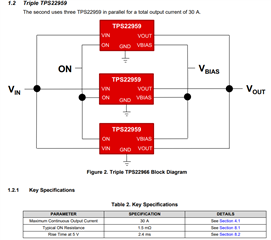Other Parts Discussed in Thread: TPS22959,
Tool/software:
Hi Sirs,
My project will plan use load-switch solution and adopt parallel multiple chips to achieve higher current output requirements, after survey to get this one link : https://www.ti.com/lit/ug/tidu859/tidu859.pdf
Based on this one shared link, I have a few question to asking as lists and please free feel to give any feedback on here, tks you!!
1. Does TI all of the load-switch can use parallel multiple chips to achieve higher current? Or, have any product limitation document on your AE internal?
2. Based on shared link about secion1.2 - Triple TPS22959 : [as snapshot picture]
(a) How to calculate the maximum output current can suffer value? (base on the internal Rds) Have any formula to share?
(b) if load-switch solution change to use TI.TPS22990 solution, how to calculate the CT/slew-rate part relative design? (I think this one is independent, right?)
Now, only have above two question to asking first, please help to clarify.
Best Regards
By Neil Chen


